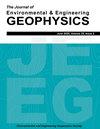Full Waveform Tomography to Address Challenges with Surface Wave Dispersion Information Caused by Significant Stochastic Variability of Subsurface Stiffness
IF 0.7
4区 工程技术
Q4 ENGINEERING, GEOLOGICAL
引用次数: 0
Abstract
Surface wave methods have increased in popularity as a means to acquire rapid and accurate shear wave velocity ( VS) profiles for engineering applications. Use of the multichannel analysis of surface waves (MASW) method, in particular, has proliferated due to multiple factors, including the ease with which strong signal-to-noise ratio can be achieved and the increased dispersion resolution offered by multichannel acquisitions. However, typical MASW processing to extract dispersion information assumes the surface waves propagate through a layered model. Errors can arise when significant lateral variability is present in the underlying stratigraphy as encountered in certain geologic settings such as residual deposits. This study investigated the effects of such variability on the dispersion information acquired with MASW. In particular, a spatially-correlated Gaussian random field was used to model the natural fluctuations in stiffness introduced by depositional processes, which differs from the approach in other studies where more specific anomalous features have been explored. Numerical modeling was subsequently performed to simulate surface wave propagation in the representative geotechnical site condition. The recovered surface waves were used to develop a subsurface stiffness profile using a dispersion-based pseudo-2D MASW approach and a tomographic approach using full waveform inversion (FWI). The results demonstrate that considerable natural spatial variability significantly complicates interpretation of dispersion information in two primary ways: (1) uncertainty can arise regarding what the dispersion curve exactly quantifies since none of the underlying VS profiles nor the average VS profile are obtained; and (2) the dispersion images exhibit evidence of false depth-related dispersion information indicative of multiple “fundamental” modes from the superposition of multiple stratigraphic units. The FWI procedure that bypasses extraction of dispersion information was found to better recover the underlying subsurface conditions when compared to the pseudo-2D MASW results at the cost of additional computational efforts.全波形层析成像解决由地下刚度显著随机变化引起的表面波色散信息的挑战
表面波法作为一种获得快速准确的剪切波速(VS)剖面的方法在工程应用中越来越受欢迎。特别是,由于多种因素,多通道表面波分析(MASW)方法的使用已经激增,包括可以轻松实现强信噪比和多通道采集提供的更高色散分辨率。然而,用于提取色散信息的典型MASW处理假设表面波通过分层模型传播。当在某些地质环境(如残余沉积物)中遇到的下伏地层中存在显著的横向变异性时,可能会出现误差。本研究探讨了这种可变性对用微波波获得的色散信息的影响。特别是,使用空间相关的高斯随机场来模拟沉积过程引入的刚度自然波动,这与其他研究中探索更具体的异常特征的方法不同。随后进行了数值模拟,以模拟具有代表性的岩土场地条件下的表面波传播。使用基于色散的伪2d MASW方法和使用全波形反演(FWI)的层析方法,利用恢复的表面波来开发亚表面刚度剖面。结果表明,相当大的自然空间变异性使色散信息的解释在两个主要方面变得非常复杂:(1)由于没有获得潜在的VS剖面和平均VS剖面,因此色散曲线精确量化的内容可能会产生不确定性;(2)色散图像显示了与深度相关的虚假色散信息,表明多个地层单元叠加的多重“基本”模式。与伪2d MASW结果相比,绕过弥散信息提取的FWI程序可以更好地恢复潜在的地下条件,但需要额外的计算工作量。
本文章由计算机程序翻译,如有差异,请以英文原文为准。
求助全文
约1分钟内获得全文
求助全文
来源期刊

Journal of Environmental and Engineering Geophysics
地学-地球化学与地球物理
CiteScore
2.70
自引率
0.00%
发文量
13
审稿时长
6 months
期刊介绍:
The JEEG (ISSN 1083-1363) is the peer-reviewed journal of the Environmental and Engineering Geophysical Society (EEGS). JEEG welcomes manuscripts on new developments in near-surface geophysics applied to environmental, engineering, and mining issues, as well as novel near-surface geophysics case histories and descriptions of new hardware aimed at the near-surface geophysics community.
 求助内容:
求助内容: 应助结果提醒方式:
应助结果提醒方式:


